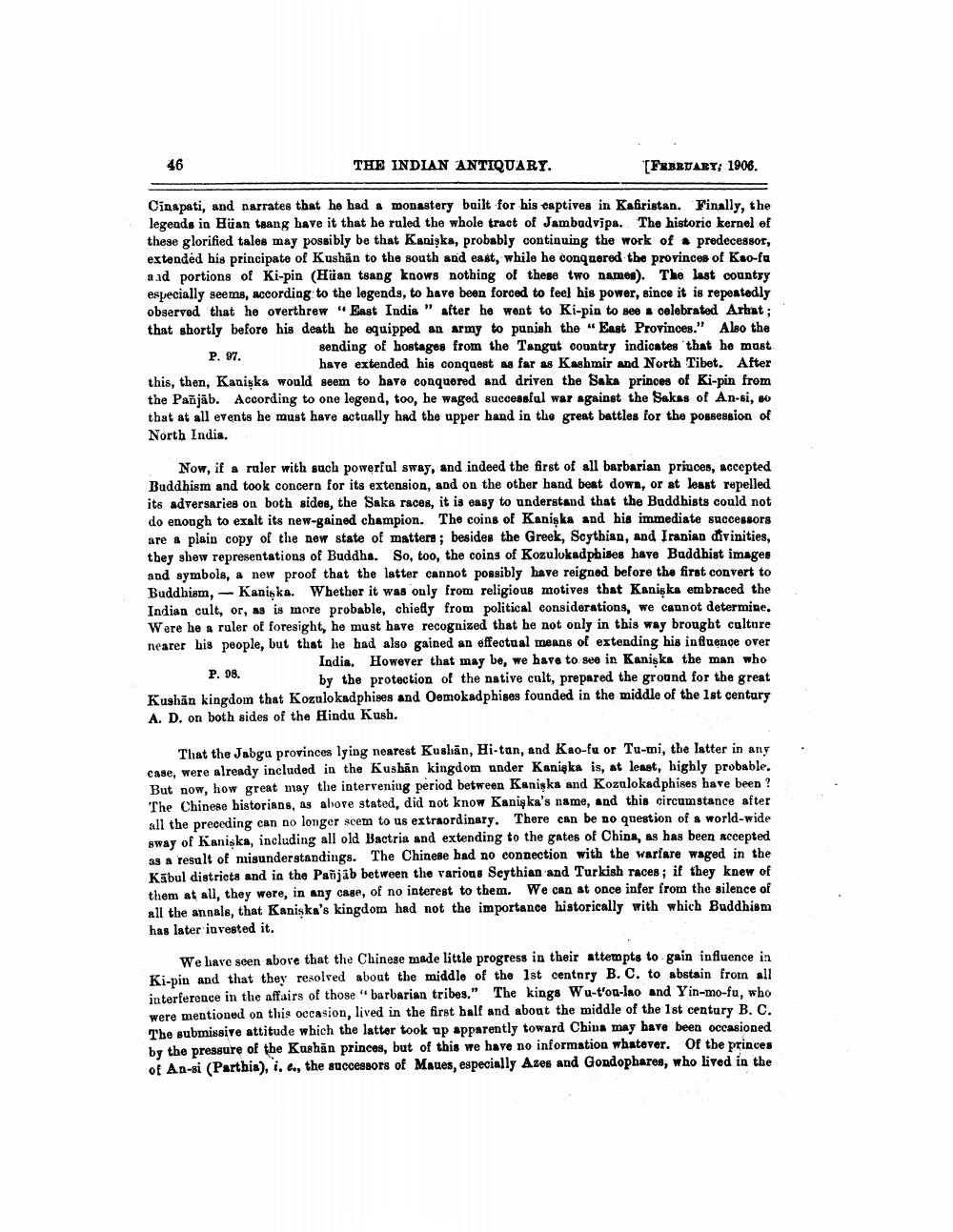________________
THE INDIAN ANTIQUARY.
[FEBRUARY; 1906.
Cinapati, and narrates that he had a monastery built for his captives in Kafiristan. Finally, the legends in Hüan tsang have it that he ruled the whole tract of Jambudvipa. The historic kernel of these glorified tales may possibly be that Kaniska, probably continuing the work of a predecessor, extended his principate of Kushan to the south and east, while he conquered the provinces of Kao-fu and portions of Ki-pin (Hüan tsang knows nothing of these two names). The last country especially seems, according to the legends, to have been forced to feel his power, since it is repeatedly observed that he overthrew "East India" after he went to Ki-pin to see a celebrated Arbat; that shortly before his death he equipped an army to punish the "East Provinces." Also the sending of hostages from the Tangut country indicates that he must have extended his conquest as far as Kashmir and North Tibet. After this, then, Kaniska would seem to have conquered and driven the Saka princes of Ki-pin from the Pañjab. According to one legend, too, he waged successful war against the Sakas of An-si, so that at all events he must have actually had the upper hand in the great battles for the possession of North India.
P. 97.
46
Now, if a ruler with such powerful sway, and indeed the first of all barbarian princes, accepted Buddhism and took concern for its extension, and on the other hand beat down, or at least repelled its adversaries on both sides, the Saka races, it is easy to understand that the Buddhists could not do enough to exalt its new-gained champion. The coins of Kaniska and his immediate successors are a plain copy of the new state of matters; besides the Greek, Scythian, and Iranian divinities, they shew representations of Buddha. So, too, the coins of Kozulokadphises have Buddhist images and symbols, a new proof that the latter cannot possibly have reigned before the first convert to Buddhism, Kaniska. Whether it was only from religious motives that Kaniska embraced the Indian cult, or, as is more probable, chiefly from political considerations, we cannot determine. Were he a ruler of foresight, he must have recognized that he not only in this way brought culture nearer his people, but that he had also gained an effectual means of extending his influence over India. However that may be, we have to see in Kaniska the man who by the protection of the native cult, prepared the ground for the great Kushan kingdom that Kozulokadphises and Oemokadphises founded in the middle of the 1st century A. D. on both sides of the Hindu Kush.
P. 98.
-
That the Jabgu provinces lying nearest Kushan, Hi-tan, and Kao-fu or Tu-mi, the latter in any case, were already included in the Kushan kingdom under Kaniska is, at least, highly probable. But now, how great may the intervening period between Kaniska and Kozulokadphises have been? The Chinese historians, as above stated, did not know Kaniska's name, and this circumstance after all the preceding can no longer seem to us extraordinary. There can be no question of a world-wide sway of Kaniska, including all old Bactria and extending to the gates of China, as has been accepted as a result of misunderstandings. The Chinese had no connection with the warfare waged in the Kabul districts and in the Pañjab between the various Seythian and Turkish races; if they knew of them at all, they were, in any case, of no interest to them. We can at once infer from the silence of all the annals, that Kaniska's kingdom had not the importance historically with which Buddhism has later invested it.
We have seen above that the Chinese made little progress in their attempts to gain influence in Ki-pin and that they resolved about the middle of the 1st century B. C. to abstain from all interference in the affairs of those "barbarian tribes." The kings Wu-t'on-lao and Yin-mo-fu, who were mentioned on this occasion, lived in the first half and about the middle of the 1st century B. C. The submissive attitude which the latter took up apparently toward China may have been occasioned by the pressure of the Kushan princes, but of this we have no information whatever. Of the princes of An-si (Parthia), i. e., the successors of Maues, especially Azes and Gondophares, who lived in the




